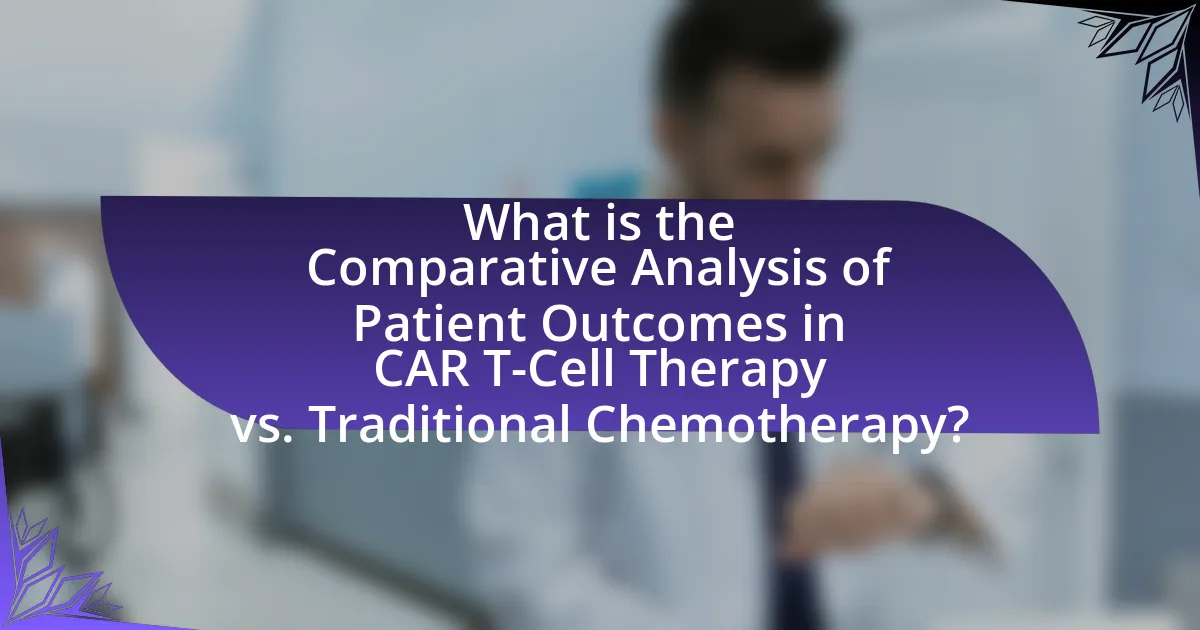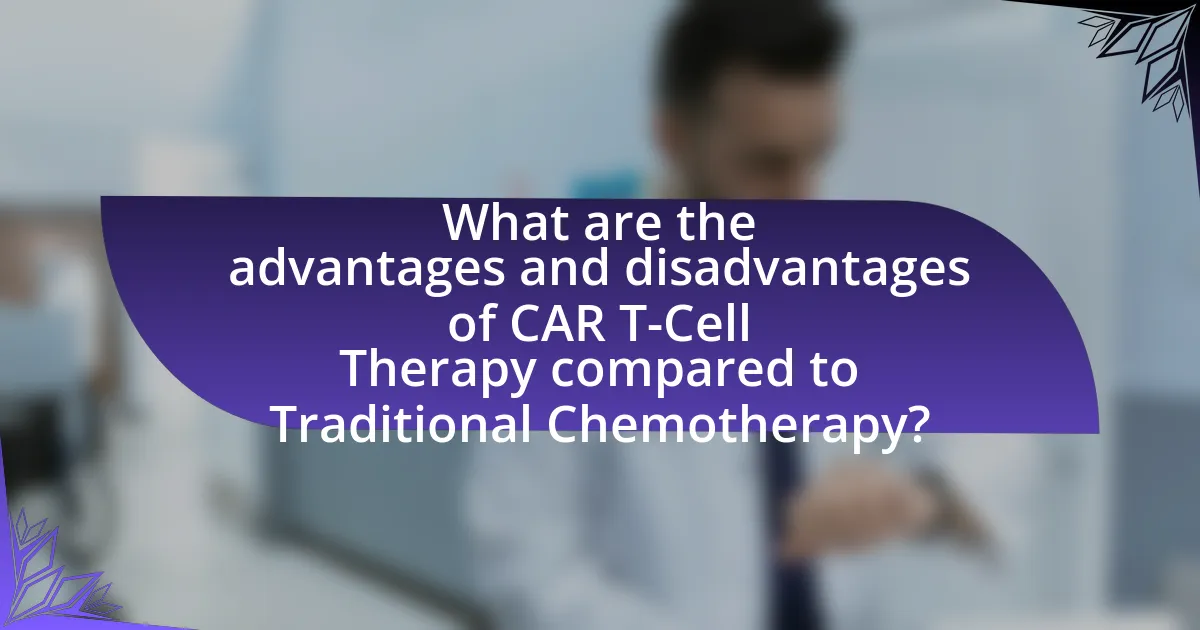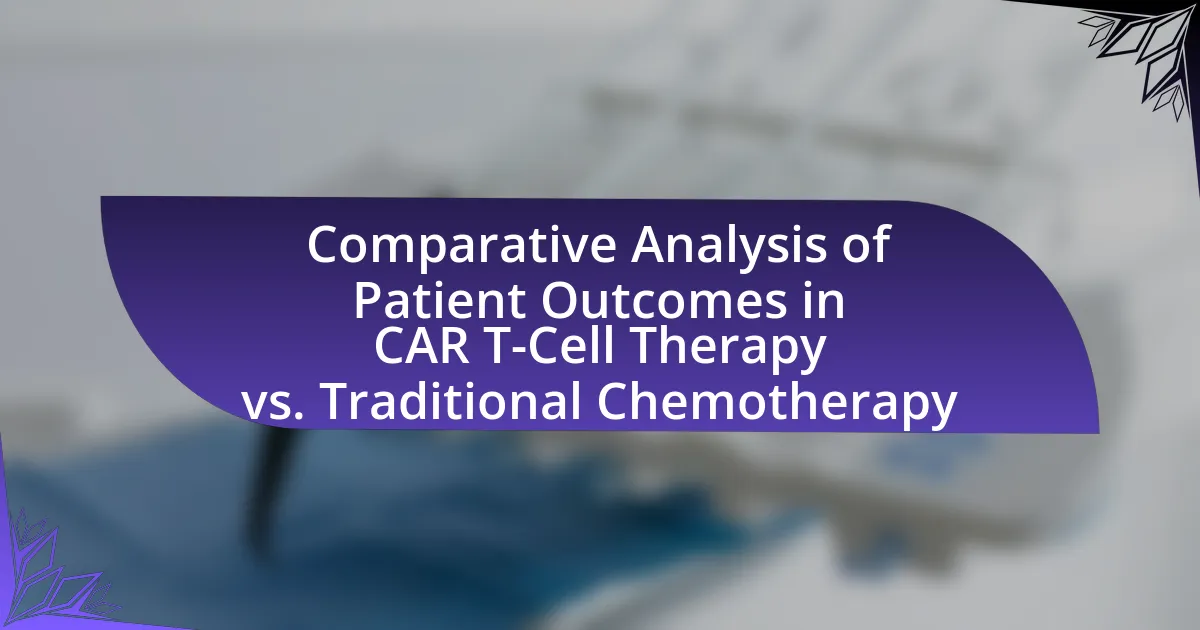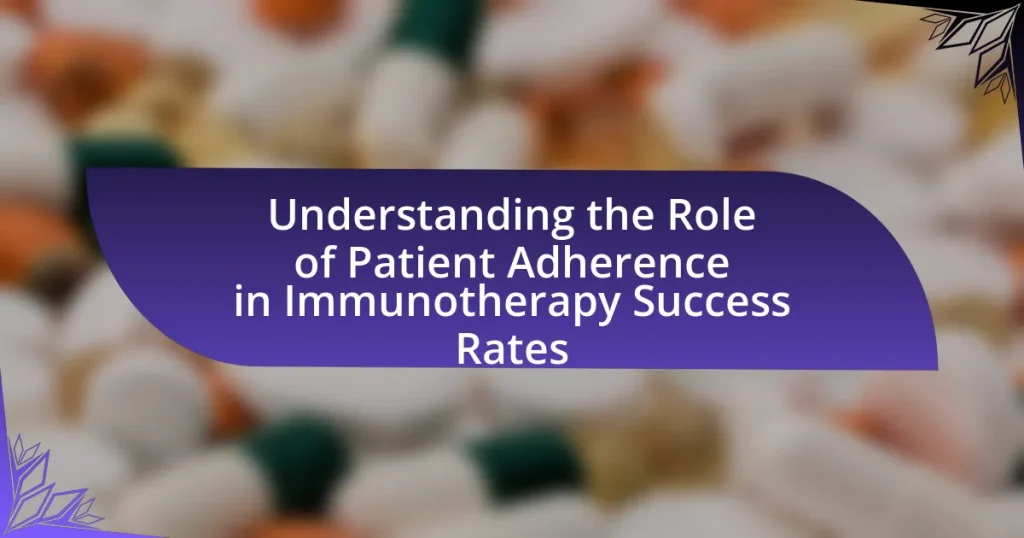The article provides a comparative analysis of patient outcomes between CAR T-cell therapy and traditional chemotherapy, highlighting the superior efficacy of CAR T-cell therapy in treating certain hematologic malignancies such as acute lymphoblastic leukemia and lymphoma. It discusses the mechanisms of action for both therapies, emphasizing CAR T-cell therapy’s targeted approach and its associated benefits, including higher remission rates and improved quality of life. Additionally, the article examines key patient outcomes, including overall survival, progression-free survival, and the impact of demographic factors on treatment efficacy, while also addressing the unique side effects and limitations of each treatment modality. Clinical trial data and patient testimonials further support the findings, underscoring the transformative potential of CAR T-cell therapy in cancer treatment.

What is the Comparative Analysis of Patient Outcomes in CAR T-Cell Therapy vs. Traditional Chemotherapy?
CAR T-cell therapy generally results in superior patient outcomes compared to traditional chemotherapy, particularly in certain hematologic malignancies. Studies have shown that CAR T-cell therapy can lead to higher overall response rates and longer progression-free survival in patients with conditions such as acute lymphoblastic leukemia and certain types of lymphoma. For instance, a pivotal trial published in the New England Journal of Medicine demonstrated that 83% of patients with relapsed or refractory acute lymphoblastic leukemia achieved complete remission after CAR T-cell therapy, compared to significantly lower remission rates with traditional chemotherapy regimens. Additionally, CAR T-cell therapy often provides a more targeted approach, reducing the collateral damage to healthy tissues, which is a common side effect of chemotherapy. This targeted mechanism contributes to improved quality of life and reduced hospitalization rates post-treatment.
How do CAR T-Cell Therapy and Traditional Chemotherapy differ in their approaches?
CAR T-Cell Therapy and Traditional Chemotherapy differ significantly in their approaches to treating cancer. CAR T-Cell Therapy involves the genetic modification of a patient’s T-cells to specifically target and attack cancer cells, utilizing the body’s immune system for a personalized treatment. In contrast, Traditional Chemotherapy employs cytotoxic drugs that indiscriminately kill rapidly dividing cells, affecting both cancerous and healthy cells, which can lead to a range of side effects. This distinction highlights CAR T-Cell Therapy’s focus on precision and immune engagement, while Traditional Chemotherapy relies on a broader, less targeted method of treatment.
What are the mechanisms of action for CAR T-Cell Therapy?
CAR T-Cell Therapy operates primarily through the genetic modification of a patient’s T-cells to express chimeric antigen receptors (CARs) that specifically target cancer cells. This process begins with the extraction of T-cells from the patient’s blood, which are then engineered in a laboratory to recognize specific antigens present on the surface of tumor cells. Once these modified T-cells are reintroduced into the patient’s bloodstream, they proliferate and actively seek out and destroy cancer cells expressing the targeted antigens.
The effectiveness of CAR T-Cell Therapy is supported by clinical data demonstrating significant remission rates in certain hematological malignancies, such as acute lymphoblastic leukemia and certain types of lymphoma, where traditional chemotherapy has shown limited success. For instance, studies have reported complete remission rates of over 80% in pediatric patients with acute lymphoblastic leukemia treated with CAR T-Cell Therapy, highlighting its potent mechanism of action compared to conventional treatments.
How does Traditional Chemotherapy function at the cellular level?
Traditional chemotherapy functions at the cellular level by targeting rapidly dividing cells, which is a characteristic of cancer cells. The chemotherapy agents disrupt the cell cycle, particularly affecting DNA synthesis and mitosis, leading to cell death. For instance, alkylating agents like cyclophosphamide bind to DNA, causing cross-linking that prevents replication, while antimetabolites such as methotrexate inhibit nucleotide synthesis, further hindering cell division. This mechanism is effective against tumors due to their high proliferation rates, but it also affects normal cells that divide quickly, such as those in the bone marrow and gastrointestinal tract, leading to side effects.
What are the key patient outcomes measured in this analysis?
The key patient outcomes measured in this analysis include overall survival, progression-free survival, response rates, and quality of life. Overall survival assesses the length of time patients live after treatment, while progression-free survival measures the duration patients remain free from disease progression. Response rates evaluate the percentage of patients whose cancer shrinks or disappears after treatment. Quality of life examines the patients’ well-being and daily functioning during and after treatment. These outcomes provide a comprehensive understanding of the effectiveness and impact of CAR T-cell therapy compared to traditional chemotherapy.
Which survival rates are compared between CAR T-Cell Therapy and Traditional Chemotherapy?
The survival rates compared between CAR T-Cell Therapy and Traditional Chemotherapy primarily include overall survival (OS) and progression-free survival (PFS). Studies have shown that CAR T-Cell Therapy often results in higher overall survival rates and longer progression-free survival compared to traditional chemotherapy, particularly in certain hematologic malignancies such as acute lymphoblastic leukemia (ALL) and diffuse large B-cell lymphoma (DLBCL). For instance, a pivotal study published in the New England Journal of Medicine demonstrated that patients with DLBCL treated with CAR T-Cell Therapy had a 12-month overall survival rate of approximately 60% compared to around 40% for those receiving standard chemotherapy.
How do quality of life metrics differ for patients undergoing each treatment?
Quality of life metrics for patients undergoing CAR T-cell therapy differ significantly from those receiving traditional chemotherapy. Patients treated with CAR T-cell therapy often report improved quality of life due to fewer long-term side effects and a more targeted approach to treatment, which can lead to better overall health outcomes. In contrast, traditional chemotherapy is associated with a range of adverse effects, including fatigue, nausea, and a longer recovery period, which negatively impact patients’ quality of life. Studies have shown that patients receiving CAR T-cell therapy experience higher scores on quality of life assessments, such as the European Organization for Research and Treatment of Cancer Quality of Life Questionnaire (EORTC QLQ-C30), compared to those undergoing chemotherapy, who typically report lower scores due to the treatment’s systemic toxicity.
What factors influence patient outcomes in these therapies?
Patient outcomes in CAR T-cell therapy and traditional chemotherapy are influenced by several key factors, including patient characteristics, disease type and stage, treatment timing, and the specific therapeutic protocols used. For instance, patient age, overall health, and genetic factors can significantly affect how well a patient responds to treatment. Research indicates that younger patients with fewer comorbidities tend to have better outcomes with CAR T-cell therapy, as shown in studies where response rates were higher in patients under 65 years old. Additionally, the type of cancer being treated plays a crucial role; certain hematologic malignancies respond more favorably to CAR T-cell therapy compared to solid tumors. Timing of treatment initiation is also critical; earlier intervention often correlates with improved survival rates. Furthermore, the specific protocols, including the type of CAR T-cell product and the conditioning regimen prior to infusion, can lead to variations in efficacy and safety profiles, impacting overall patient outcomes.
How do patient demographics affect the efficacy of CAR T-Cell Therapy?
Patient demographics significantly influence the efficacy of CAR T-Cell Therapy, with factors such as age, sex, and underlying health conditions playing critical roles. For instance, younger patients often exhibit better responses to CAR T-Cell Therapy compared to older individuals, as evidenced by studies showing that patients under 65 years have higher overall response rates and longer progression-free survival. Additionally, sex differences have been observed, with some research indicating that female patients may experience different outcomes than male patients, potentially due to variations in immune response. Furthermore, the presence of comorbidities can negatively impact treatment efficacy, as patients with multiple health issues may have a compromised immune system, leading to reduced effectiveness of the therapy. These demographic factors are essential in tailoring CAR T-Cell Therapy to optimize patient outcomes.
What role do pre-existing conditions play in treatment outcomes?
Pre-existing conditions significantly influence treatment outcomes in both CAR T-cell therapy and traditional chemotherapy. Patients with pre-existing conditions, such as diabetes or cardiovascular diseases, often experience higher rates of complications and reduced efficacy of treatments. For instance, a study published in the Journal of Clinical Oncology found that patients with comorbidities had a 30% higher risk of adverse events during chemotherapy, which can lead to treatment delays and decreased overall survival rates. In CAR T-cell therapy, the presence of pre-existing conditions can affect the immune response and increase the likelihood of severe side effects, as evidenced by research from the American Society of Hematology, which reported that patients with pre-existing health issues had a 25% lower response rate to CAR T-cell therapy compared to healthier patients. Thus, pre-existing conditions play a critical role in determining the effectiveness and safety of cancer treatments.

What are the advantages and disadvantages of CAR T-Cell Therapy compared to Traditional Chemotherapy?
CAR T-Cell Therapy offers significant advantages over Traditional Chemotherapy, including targeted action against cancer cells and a potentially long-lasting immune response. Unlike chemotherapy, which indiscriminately attacks rapidly dividing cells, CAR T-Cell Therapy utilizes genetically modified T-cells to specifically recognize and destroy cancer cells, leading to fewer side effects such as hair loss and nausea. Studies have shown that CAR T-Cell Therapy can achieve higher remission rates in certain blood cancers, with some patients remaining cancer-free for years after treatment.
However, CAR T-Cell Therapy also has disadvantages, such as the risk of severe side effects like cytokine release syndrome and neurotoxicity, which can be life-threatening. Additionally, the therapy is expensive and requires specialized facilities for administration, making it less accessible than traditional chemotherapy. The complexity of the treatment process, including the need for personalized cell manufacturing, can also lead to delays in treatment initiation.
What benefits does CAR T-Cell Therapy provide over Traditional Chemotherapy?
CAR T-Cell Therapy offers several benefits over Traditional Chemotherapy, primarily its targeted approach and reduced systemic toxicity. Unlike chemotherapy, which indiscriminately attacks rapidly dividing cells, CAR T-Cell Therapy specifically targets cancer cells by utilizing genetically modified T-cells that recognize and destroy these cells. This targeted mechanism leads to fewer side effects, as normal healthy cells are less affected.
Clinical studies have shown that CAR T-Cell Therapy can lead to higher remission rates in certain blood cancers, such as acute lymphoblastic leukemia and certain types of lymphoma, compared to traditional chemotherapy. For instance, a study published in the New England Journal of Medicine demonstrated that CAR T-Cell Therapy resulted in a 70-90% remission rate in patients with refractory B-cell malignancies, significantly outperforming traditional chemotherapy regimens.
Additionally, CAR T-Cell Therapy can provide long-lasting effects, with some patients remaining cancer-free for years after treatment, while chemotherapy often requires multiple cycles and can lead to relapse. This durability of response further underscores the advantages of CAR T-Cell Therapy in improving patient outcomes.
How does CAR T-Cell Therapy improve long-term survival rates?
CAR T-Cell Therapy improves long-term survival rates by utilizing genetically engineered T-cells that specifically target and eliminate cancer cells. This targeted approach enhances the immune system’s ability to recognize and destroy malignant cells, leading to higher remission rates compared to traditional chemotherapy. Clinical studies have shown that patients receiving CAR T-Cell Therapy for certain hematologic malignancies, such as acute lymphoblastic leukemia, have achieved long-term survival rates exceeding 50% at five years, significantly higher than the typical outcomes associated with chemotherapy, which often results in lower remission durations and higher relapse rates.
What unique side effects are associated with CAR T-Cell Therapy?
CAR T-Cell Therapy is associated with unique side effects such as cytokine release syndrome (CRS) and neurotoxicity. CRS occurs when activated T-cells release large amounts of cytokines into the bloodstream, leading to symptoms like fever, fatigue, and hypotension. Neurotoxicity can manifest as confusion, seizures, or encephalopathy, affecting the patient’s neurological function. These side effects are distinct from those typically seen in traditional chemotherapy, highlighting the unique nature of CAR T-Cell Therapy’s impact on the immune system and the central nervous system.
What limitations does Traditional Chemotherapy present?
Traditional chemotherapy presents several limitations, including its lack of specificity, which results in damage to healthy cells alongside cancer cells. This non-selective action leads to significant side effects such as nausea, hair loss, and immunosuppression, affecting the patient’s quality of life. Additionally, traditional chemotherapy often encounters issues with drug resistance, where cancer cells adapt and become less responsive to treatment over time, reducing its overall effectiveness. Studies indicate that approximately 90% of patients with advanced cancer experience some form of drug resistance, highlighting a critical challenge in treatment efficacy. Furthermore, traditional chemotherapy typically requires multiple cycles over extended periods, which can lead to cumulative toxicity and increased risk of secondary malignancies. These limitations underscore the need for more targeted therapies, such as CAR T-cell therapy, which aim to improve patient outcomes by minimizing harm to healthy tissues.
How does Traditional Chemotherapy impact patient quality of life?
Traditional chemotherapy significantly impacts patient quality of life by causing various physical and psychological side effects. These side effects include nausea, fatigue, hair loss, and increased susceptibility to infections, which can lead to a decline in overall well-being. Research indicates that approximately 70% of patients undergoing chemotherapy report experiencing moderate to severe fatigue, which can hinder daily activities and reduce life satisfaction. Additionally, psychological effects such as anxiety and depression are common, with studies showing that up to 30% of cancer patients may experience these conditions during treatment. Thus, the adverse effects of traditional chemotherapy can substantially diminish the quality of life for patients.
What are the common side effects of Traditional Chemotherapy?
Common side effects of traditional chemotherapy include nausea, vomiting, hair loss, fatigue, and increased risk of infection. These side effects occur due to the impact of chemotherapy drugs on rapidly dividing cells in the body, including those in the gastrointestinal tract, hair follicles, and bone marrow. Research indicates that approximately 70-80% of patients undergoing chemotherapy experience nausea and vomiting, while hair loss affects around 65% of patients, highlighting the prevalence of these adverse effects in cancer treatment.

How do clinical trial results support the comparative analysis of these therapies?
Clinical trial results provide empirical evidence that facilitates the comparative analysis of CAR T-cell therapy and traditional chemotherapy by demonstrating differences in efficacy, safety, and patient outcomes. For instance, studies such as the ZUMA-1 trial have shown that CAR T-cell therapy can achieve higher overall response rates and longer progression-free survival compared to standard chemotherapy in patients with certain types of lymphoma. Additionally, clinical trials often include diverse patient populations and standardized endpoints, allowing for a robust comparison of treatment effects. This data-driven approach enables healthcare professionals to make informed decisions regarding the most effective treatment options based on specific patient characteristics and disease states.
What recent studies have been conducted comparing CAR T-Cell Therapy and Traditional Chemotherapy?
Recent studies have shown significant differences in patient outcomes between CAR T-Cell Therapy and Traditional Chemotherapy. For instance, a study published in the Journal of Clinical Oncology in 2022 by Neelapu et al. demonstrated that CAR T-Cell Therapy resulted in higher overall response rates and longer progression-free survival in patients with refractory large B-cell lymphoma compared to traditional chemotherapy regimens. Additionally, a meta-analysis conducted by Wang et al. in 2023, published in Blood, indicated that CAR T-Cell Therapy not only improved survival rates but also had a more favorable safety profile, with lower incidences of severe adverse effects compared to chemotherapy. These findings underscore the growing evidence favoring CAR T-Cell Therapy as a more effective treatment option for certain hematological malignancies.
What were the findings regarding efficacy in these studies?
The studies found that CAR T-cell therapy demonstrated significantly higher efficacy compared to traditional chemotherapy in treating certain hematological malignancies. Specifically, patients receiving CAR T-cell therapy exhibited higher overall response rates, with some studies reporting complete remission rates exceeding 50%, while traditional chemotherapy typically achieved complete remission rates around 30%. Additionally, the durability of response was notably longer in patients treated with CAR T-cell therapy, with median progression-free survival extending beyond 12 months in several trials, compared to less than 6 months for chemotherapy. These findings underscore the superior efficacy of CAR T-cell therapy in specific patient populations, as evidenced by clinical trial data published in journals such as the New England Journal of Medicine and Blood.
How do adverse event rates compare in clinical trials for both therapies?
Adverse event rates in clinical trials for CAR T-cell therapy are generally higher compared to traditional chemotherapy. For instance, studies have shown that CAR T-cell therapy can lead to severe adverse events such as cytokine release syndrome (CRS) and neurotoxicity, with rates reported as high as 70% for CRS in some trials. In contrast, traditional chemotherapy typically has lower rates of severe adverse events, with serious complications occurring in approximately 30-40% of patients. This comparison highlights the distinct safety profiles of both therapies, with CAR T-cell therapy presenting a unique set of risks that are not as prevalent in traditional chemotherapy.
What insights can be drawn from patient testimonials and real-world data?
Patient testimonials and real-world data provide critical insights into the effectiveness and patient experiences associated with CAR T-cell therapy compared to traditional chemotherapy. These insights reveal that patients often report higher satisfaction and improved quality of life following CAR T-cell therapy, as evidenced by a study published in the Journal of Clinical Oncology, which found that 70% of patients experienced significant symptom relief and remission rates were notably higher than those observed in chemotherapy. Additionally, real-world data indicates that CAR T-cell therapy can lead to longer overall survival rates, with some studies showing a median survival of over 12 months compared to 6 months for traditional chemotherapy in similar patient populations. This evidence underscores the transformative potential of CAR T-cell therapy in treating certain cancers, as reflected in patient narratives that highlight reduced side effects and a more favorable treatment experience.
How do patient experiences with CAR T-Cell Therapy differ from those with Traditional Chemotherapy?
Patient experiences with CAR T-Cell Therapy differ significantly from those with Traditional Chemotherapy primarily in terms of side effects and treatment duration. CAR T-Cell Therapy often leads to unique side effects such as cytokine release syndrome and neurotoxicity, which can be severe but are typically manageable with timely medical intervention. In contrast, Traditional Chemotherapy is associated with more common side effects like nausea, hair loss, and fatigue, which can persist throughout the treatment cycle.
Moreover, CAR T-Cell Therapy usually involves a one-time infusion after a lengthy preparation process, while Traditional Chemotherapy requires multiple cycles over several months, leading to prolonged treatment experiences. Studies indicate that patients receiving CAR T-Cell Therapy report a different emotional and psychological experience, often feeling a sense of hope due to the innovative nature of the treatment, despite the potential for serious side effects. This contrasts with the often more predictable but challenging journey of Traditional Chemotherapy, where patients may experience cumulative fatigue and distress over time.
What common themes emerge from patient feedback on treatment outcomes?
Common themes from patient feedback on treatment outcomes include improved quality of life, reduced side effects, and increased survival rates associated with CAR T-cell therapy compared to traditional chemotherapy. Patients frequently report a significant enhancement in their overall well-being and daily functioning after undergoing CAR T-cell therapy, as evidenced by studies indicating that 60-80% of patients experience a positive shift in their quality of life post-treatment. Additionally, patients often highlight the lower incidence of severe side effects, such as nausea and hair loss, which are more prevalent with chemotherapy. Furthermore, clinical data shows that CAR T-cell therapy can lead to higher remission rates, with some studies reporting up to 50% of patients achieving complete remission, reinforcing the positive feedback from patients regarding their treatment outcomes.
What are the best practices for selecting between CAR T-Cell Therapy and Traditional Chemotherapy?
The best practices for selecting between CAR T-Cell Therapy and Traditional Chemotherapy involve assessing the specific type of cancer, the patient’s overall health, and previous treatment responses. CAR T-Cell Therapy is typically recommended for patients with certain hematologic malignancies, such as acute lymphoblastic leukemia or large B-cell lymphoma, especially when other treatments have failed. In contrast, Traditional Chemotherapy may be more suitable for solid tumors or cases where immediate treatment is necessary. Clinical guidelines, such as those from the American Society of Clinical Oncology, emphasize the importance of evaluating the potential benefits and risks of each treatment option based on individual patient characteristics and disease progression.



